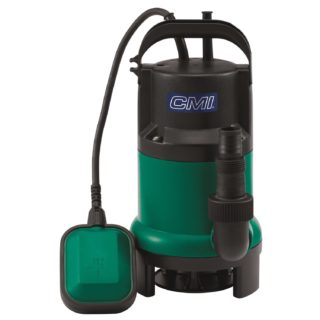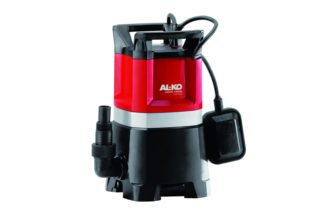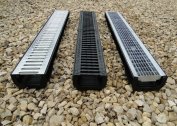To start using submersible pumping equipment, it is necessary to familiarize yourself with the conditions of its use, the scope of application and the types of equipment itself.
Basically, such equipment is used to supply water from wells and mine wells. You can use such equipment in an open tank or source. It is only necessary to observe the basic rule of use - the complete immersion of pumping equipment in the thickness of the pumped liquid. If this condition is not met, the equipment will very quickly fail and a repair or purchase of a new device will be necessary.
The design of submersible pumps is almost the same, regardless of model. Firstly, all submersible pumps have a completely sealed housing. Such a housing protects the electric motor from contact with the aquatic environment.
Submersible Pump Differences
 The size and weight category of the housing is different for all models of submersible pumping equipment. The only thing that is almost identical for such pumps is an elongated cylinder shape and a small diameter. In addition, there are still the same design features:
The size and weight category of the housing is different for all models of submersible pumping equipment. The only thing that is almost identical for such pumps is an elongated cylinder shape and a small diameter. In addition, there are still the same design features:
- All models have a coarse filter. This device is able to protect the inside of the pump from sand and small pebbles.
- All pumps have a non-return valve. It will prevent the fluid from moving in the opposite direction. This item can be installed optionally.
- The presence of the outlet pipe, the conclusions of the power cable, special clamps for securing the cable.
Advantages and disadvantages of downhole equipment
 All submersible pumps must always be in the water. Not a single detail of them can be on the surface. Such pumps are fixed on a special cable, at a certain distance from the bottom of the source.
All submersible pumps must always be in the water. Not a single detail of them can be on the surface. Such pumps are fixed on a special cable, at a certain distance from the bottom of the source.
Advantages of submersible pumps
- Almost silent operation and with minimal vibration.
- The equipment cannot freeze.
- No additional cooling system is required, because the equipment, being in the water, cannot overheat. This eliminates the possibility of quick breakdown of the pump.
- High performance. Due to this, such pumps can be used for servicing deep wells. The maximum depth of use is more than 100 meters.
- The case is made of steel alloy and is designed for a long service life.
Disadvantages of Submersible Pumps
- Difficulties in installing equipment. This is determined by the depth of the well and the design of the pumps.
- For repairs or maintenance, pumping equipment must be removed from the well shaft.
- For the equipment to work, it is necessary to install a special cable with enhanced protection against moisture.
Types of submersible equipment
Many companies that produce pumping equipment for servicing wells or wells offer the user a fairly large selection of models and varieties of hydraulic machines.
Vibratory type equipment
 The main structural element is an electric coil with a core. A special anchor creates vibration due to changes in the magnetic field. Such pumps do not have an electric motor of rotating parts in the structure. This increases reliability and promotes long-term operation of this type of pumping equipment. Among the disadvantages is the rather low productivity and inability to create a large head of the pumped liquid. Also, such pumps cannot be used in muddy and polluted water. The biggest advantage is light weight and low price.Such equipment often silts the bottom of the source and can destroy the walls of the well.
The main structural element is an electric coil with a core. A special anchor creates vibration due to changes in the magnetic field. Such pumps do not have an electric motor of rotating parts in the structure. This increases reliability and promotes long-term operation of this type of pumping equipment. Among the disadvantages is the rather low productivity and inability to create a large head of the pumped liquid. Also, such pumps cannot be used in muddy and polluted water. The biggest advantage is light weight and low price.Such equipment often silts the bottom of the source and can destroy the walls of the well.
Centrifugal Type Equipment
 The main part is the wheel, with the blades attached to it. They move the fluid that the pump pumps. Moreover, the pumping speed is large enough, which contributes to the formation of good pressure supplied to the surface of the liquid. The user can independently improve such equipment by increasing the number of wheels.
The main part is the wheel, with the blades attached to it. They move the fluid that the pump pumps. Moreover, the pumping speed is large enough, which contributes to the formation of good pressure supplied to the surface of the liquid. The user can independently improve such equipment by increasing the number of wheels.
Of the benefits include:
- Almost silent work.
- High performance.
- The ability to use at a sufficiently large depth.
- Creating a large head of fluid.
Disadvantages:
- High price.
- Complex installation work is required during installation.
Screw pumping equipment
Such equipment is rarely used and is not popular. They are suitable for pumping viscous and highly contaminated liquids. They can be used at great depths. Of the drawbacks is the frequent replacement of parts that are erased or broken due to friction.
Vortex pumping equipment
The principle of operation of such equipment is similar to centrifugal pumps. Only vortex pumps are much more powerful than them. Of the advantages, a simple design and the ability to pump fluid in which there is any gas can be noted. These devices must not be used for pumping liquids with sand, small stones or sludge.


